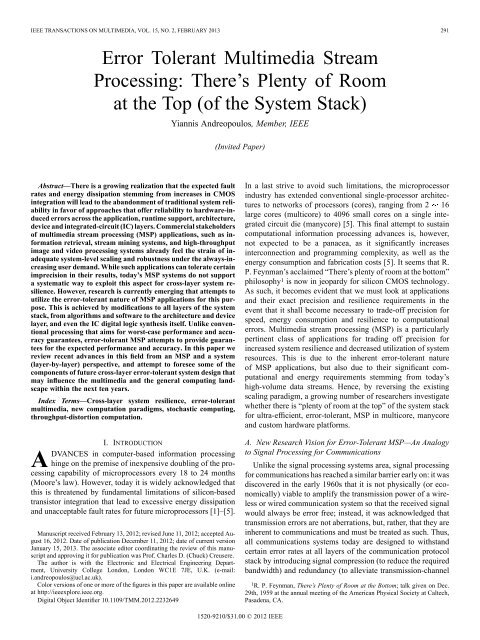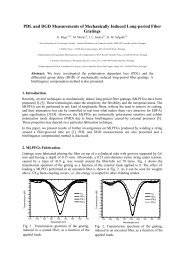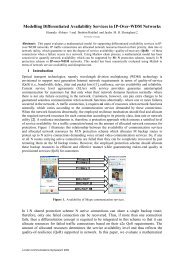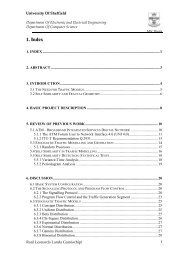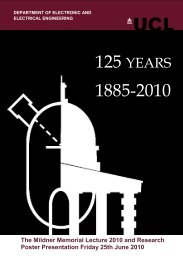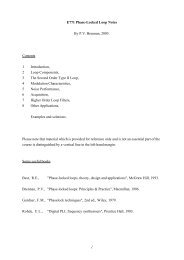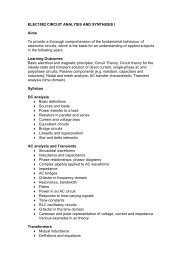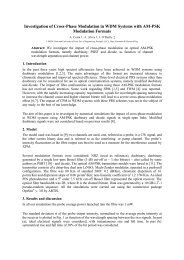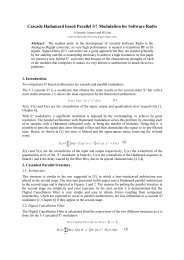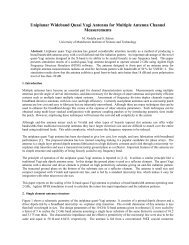Error Tolerant Multimedia Stream Processing: There's ... - IEEE Xplore
Error Tolerant Multimedia Stream Processing: There's ... - IEEE Xplore
Error Tolerant Multimedia Stream Processing: There's ... - IEEE Xplore
Create successful ePaper yourself
Turn your PDF publications into a flip-book with our unique Google optimized e-Paper software.
ANDREOPOULOS: ERROR TOLERANT MULTIMEDIA STREAM PROCESSING: THERE’S PLENTY OF ROOM AT THE TOP (OF THE SYSTEM STACK) 293Fig. 2. <strong>Multimedia</strong> stream processing applications viewed from a system perspective. Compute-intensive routines consist of digital signal processing primitives(e.g., convolution, decomposition and template matching), linear algebra routines (e.g., matrix multiplication, system inversion and matrix factorizations), datadependentalgorithms such as entropy coding or probability table updates, etc.of CMOS technology [5], [11], [19]. Planet-level SP serviceslike Google, Facebook, Twitter & Amazon EC2 already feel thestrain of energy consumption and throughput limitation createdby millions of tasks per second. Faced with a 100-fold predictedincrease of processing volume within the next few years due tonew applications and new users, their only avenue for handlingsuch demand would be to utilize systematic approaches for precision/fault-tolerance/performance.This is also reflected in recentexascale computing studies, which state that, to achievethe leap from petaFLOP to exaFLOP computing (fromto operations per second) by 2020: “The [numerical] librariesmust be able to find optimal mapping of the requiredprecision in terms of speed, precision, and energy usage”. and“Ideally, the user could specify the required precision for theresult, and the algorithm would choose the best combinationof precision on the local hardware in order to achieve it. Theactual mechanics would be hidden from the user”. [[19], pp.27, 31]. This critical aspect of dynamic precision adaptationwithin MSP is prominently highlighted in this paper, and algorithm-orientedand systems-oriented possible solutions are reviewedin Sections II and III.D. Paper OrganizationIn this paper we survey previous and on-going efforts for errortolerance in multimedia systems with a view towards enablingfuture high-performance multimedia systems to circumvent thelimitations of technology scaling. Section II takes an application-orientedapproach and presents a review of existing workon complexity-precision scaling and error tolerance in multimediastream processing systems. In a complementary manner,Section III takes a system-oriented view and presents some recentand emerging research efforts 2 in all layers of the system2 This section also highlights related papers published in the same issue as thisoverview paper.stack, from high-performance software libraries to the hardwarecomponents layer. Section IV attempts to consolidate thesetwo viewpoints by highlighting possibilities for advanced multimediacomputing systems that incorporate error tolerance bothfor specific applications and for specific system layers in an integratedmanner. Finally, Section V provides some concludingremarks.II. ERROR-TOLERANT MULTIMEDIA SYSTEMSFOR RESOURCE-DISTORTION ADAPTATIONIn this section, we review multimedia applications and theirpotential for tolerance to errors by the production of approximateresults, either by component adaptation (e.g., changes inthe transform decomposition of a video coding system) or bysystem-level resource-precision optimization. We separate thediscussion in three categories: (a) stream representation, analysisand coding; (b) information indexing and multimedia retrievalsystems; (c) learning and recognition applications. Thesethree classes of applications encompass a wide range of MSPsystems used in practice.A. <strong>Stream</strong> Representation, Analysis and CodingThese are applications that make heavy use of matrix multiplication,matrix-vector products, short-length convolution,multidimensional transform decompositions, and data-dependentmemory-intensive processing as their computationally-intensivekernels (see Fig. 1 and Fig. 2). Examples are: transformanalysis and synthesis, motion estimation and compensation,entropy encoding or decoding, graphics rendering and animation[15], [16], super-resolution and construction of large 3Dscenes from multiple views [20], etc.1) General Theory: Pearl examined the notion of complexityfor inexact computations [21] and established boundson the minimum complexity of assigning a number of distinctcalculations to a number of machines (or “computation units”)under predetermined average distortion in the result. It is
294 <strong>IEEE</strong> TRANSACTIONS ON MULTIMEDIA, VOL. 15, NO. 2, FEBRUARY 2013Fig. 3. Top: Conventional transform coding system; bottom: Reversal of quantizationand transform leading to the utilization of a low-bitwidth integer transformand universal entropy coding.shown that providing exact complexity estimates is hard asboth complexity and distortion are problem-dependent. Forexample, in an approximate sorting algorithm that performsswaps of two elements at each step, complexity can be definedas the number of steps performed; at the same time, distortionis “the damage incurred [to the application] by receiving thepartially sorted list [..] instead of the fully sorted one” [21].On the other hand, when generating specified binary sequencesof finite length with sequential circuits (e.g., in the case ofchannel decoding with the Vitterbi algorithm), complexity canbe defined as the number of states the machine mustemploy,while distortion can be defined by the Hamming distance [21].Pearl shows that complexity bounds of such problems dependon the maximum number of possible assignments of tasksto computation units, which is lower bounded via Shannon’srate-distortion function when computed on the input data.This indicates that, asymptotically, both the complexity of acomputer program and its execution time vary according tothe rate-distortion function of the input stream to be processed.This was indeed proven much later by Sow and Eleftheriadis[22] under the assumption of an elementary computing system(Turing machine). For systems aiming at signal representations,denoising and coding, the investigation of links between therate-distortion and the complexity-distortion functions remainsan active area of research [23], [24].Given that complexity bounds for Turing machine automataunder approximate results may not map well to real-world executiontime complexity of a modern-day computing machine,several authors proposed theoretical analysis for specific casesof transforms decompositions in coding systems. Goyal andVetterli [25] investigated the relationship between scalar quantizationand transform decompositions in coding of Gaussiansources. Assuming signal-dependent optimal decompositions(such as the Karhunen-Loeve transform) they show that, unlikethe conventional design (Fig. 3), scalar quantization canprecede the transform, a bitplane quantizer can be employedand, under a discrete approximation of the transform design(i.e., integer-to-integer mapping), very similar rate-distortionperformance can be achieved even under the widely-used caseof scalar entropy coding. Moreover, the use of an integer-to-integertransform allows for complexity reduction because thesame entropy code can be used for all transform coefficientsand the wordlength used for the implementation can be reducedsignificantly [26].Advanced aspects on reversing the order of quantization andtransform in analysis or coding systems were also investigatedindependently by Nawab, Chandrakasan, et al. [27], [28], Andreopouloset al. [29]–[31], and Lee et al. [32] with respect toincremental (progressive) computation and fixed-quantizationfor Fourier transforms and discrete wavelet transforms computations.Discretizing the input to the transform by processinginput images in a bitplane-by-bitplane manner has the advantagethat it can be computed using look-up tables or small-bitwidthcomputations. This was proposed for the discrete cosine transforms(DCT) [33] and the discrete wavelet transform [29]. Suchapproaches also have the advantage that each input layer can beprocessed independently (thus introducing bit-level parallelism)and computational faults introduced by the hardware can beaddressedin an inherently layered manner by scheduling the mostsignificant bitplanes to the most reliable computational cores orunits [33]. In addition, the required quantization and transformprecision can be optimally adapted according to the energy consumptionor complexity (computations) budget and the application’sprecision profile [29], [32].2) Rate-Distortion-Complexity Modeling of <strong>Multimedia</strong>Analysis and Coding Systems: Beyond the interplay betweenthe quantization and the transform decomposition and itsimpact in the rate-distortion-complexity (R-D-C) space, otherworks investigated new representations that can enable scalableR-D-C models of transform systems. For Fourier analysis,Chen and Sundaram proposed the preprocessing of signals byfixed polynomial basis functions followed by weighted Fouriertransforms of the pre-computer basis functions [34]. This enabledoperational complexity-distortion points not achievableby conventional fast Fourier transform (FFT) computations.For R-D-C scalability of larger systems (e.g., an entire imageor video encoder or decoder), it was identified early on thatappropriate complexity metrics are required [35]–[38]. Ratherthan focusing on execution time [39], task-specific complexitymetrics can be defined, such as the number of entropy codingoperations, the number of motion compensated predictionoperations and the number of symbol encoding or decodingoperations [35]–[38], [40]–[42]. These algorithm-specific metricshave been termed as generic complexity metrics (GCMs)and their impact in real systems was defined as real complexitymetrics (RCMs) [35]. A particular algorithm and its realizationin software or hardware can be modeled with respect to itsGCMs and their mapping to RCMs. GCM decompositionframeworks for the analysis of the operations performed fora particular video encoding or decoding were proposed inrecent work [36]. For multi-view image coding and decodingsystems, GCM-alike complexity models and their mapping toreal complexity (in terms of time and memory usage) and thecorresponding rate-distortion (R-D) characteristics were proposed[40], [41]. The link between complexity metrics and dataflow models and directed acyclic graphs has been discussed inthe overview paper of Lee et al. [43]. Importantly, similar toprevious works, the authors highlight that R-D optimization isonly a subcase of the general R-D-C optimization problem of amultimedia encoder or decoder.3) Links to System-Level Complexity Adaptation and Complexity-DistortionScalability: The R-D-C characteristics ofrepresentation, analysis and coding systems for multimedia
296 <strong>IEEE</strong> TRANSACTIONS ON MULTIMEDIA, VOL. 15, NO. 2, FEBRUARY 2013tasks, protecting the data-memory space using error controlcoding (ECC) circuits is not important, as learning and recognitionalgorithms will scale their recognition rate gracefully inthepresenceofdataerrors.However, protection of data loopindexing and instruction memory variables is important aserrors in the algorithm flow could cause severe distortions.III. SYSTEM-ORIENTED OVERVIEW OF ERROR-TOLERANTMULTIMEDIA STREAM PROCESSINGGiven the possibilities for resource/distortion scaling presentedfor the broad classes of multimedia stream processingapplications of the previous section, we elaborate on the differentpossibilities of practical system adjustment for resourcescaling and resilience under approximations of outputs or thepotential existence of processing errors stemming from thesoftware, scheduling, architecture, or hardware layers. Unlikethe previous section that focused on particular classes ofmultimedia stream processing algorithms, here we summarizeresearch advances in system layers, from the software layer tothe architecture, device and IC layers.A. Advances in Approximate (Precision-Aware) <strong>Multimedia</strong><strong>Stream</strong> <strong>Processing</strong> Software ComponentsIn the software layer, the de-facto standard libraries for highperformanceMSP today are the Basic Linear Algebra Subprograms(BLAS), the Linear Algebra Package (LAPACK) anddigital signal processing or computer vision libraries. Severaloptimized designs exist for these, focusing on single-instruction-multiple-dataarchitectures (e.g., NAG, Goto [68], ATLAS,Intel IPP, OpenCV, Matlab, and AMD ACML), manycore platforms(e.g., Matlab Parallel Computing Toolbox, PLASMA/MAGMA [69]), and embedded processors (e.g., Eigen for ARMNeon).All high-performance realizations of MSP algorithms tryto make maximum usage of computational kernels of suchlibraries to ensure their realization remains as modular andhighly-optimized as possible. This modularization also allowsfor automated design flows that can optimally selecthardware resources from a multi-component architecture fordata-dominated MSP algorithm flows [17], [18], [70]. Finally,the importance of this modularization of algorithmic componentsinto high-performance computational kernels of softwarelibraries is demonstrated by the recent definition of the reconfigurablevideo coding specification [71] within MPEG videocoding standards.We first review conventional acceleration and fault-toleranceapproaches and then present some emerging ideas onthroughput-distortion scaling of computation for linear algebraoperations that form the compute- and memory-intensive softwarekernels (primitives) of the error-tolerant MSP applicationsof the previous section.1) Acceleration Techniques and Conventional Fault Tolerance:Acceleration techniques for these libraries generallyfollow two different approaches: tailoring and customizing thecomputational routines to particular systems (e.g., to exploitproblem-specific sparsity for sparse linear solvers) [72], orexploiting mixed precision for accelerated processing in certaincomputations, e.g., for iterative linear solvers [73]. In bothcases, notable accelerations have been reported via the use ofmanycore platforms, hybrid multicore/manycore systems, orreconfigurable systems [18]. State-of-the-art designs today use<strong>Stream</strong>ing SIMD Extensions (SSE) for multicore processorsand automated parallelization within the compilation andscheduling, e.g., via the CUDA and OpenCL frameworks.In terms of tolerance to hardware-induced errors, conventionalfault tolerance techniques follow ECC approaches in software[74], [75] or hardware [55], [76]. These approaches createredundant computations composed of mixtures of the existinginput data in a linear operation (e.g., matrix product or convolution)and form checkpoints from the redundant computationsin order to check the useful results for correctness using paritybits or Hamming codes. They generally incur 70 150% performancepenalty in terms of the achieved giga floating-pointoperations per second (GFLOPS) [75], [76] and they can onlydetect and correct a limited number of errors per computation,typically one or two errors per input substream of data. Complementaryto such general-purpose fault-tolerant approaches,error tolerance in software or hardware for MSP was proposedby Breuer, Ortega et al. [77]–[79] by exploiting the fact thatmultimedia operations such as motion estimation and filteringtend to create localized errors that can be maskedfromtheuserifdetected or treated properly. As an example, Chung and Ortega[78] analyzed the motion estimation of an MPEG encoder basedon an RTL implementation of the algorithm and concluded thatmost hardware-induced faults either did not create an error in theoutput or they only led to bandwidth increases due to erroneousmotion vector estimation or redundant frame transmissions.While these approaches for acceleration and error toleranceare certainly encouraging, they still fail to capture the massiveparallelism offered by the hardware platforms themselves or,for mixed-precision methods, the speed-vs.-accuracy trade-offbetween single and double-precision floating point. In fact, itis becoming all the more evident that massively parallel architecturestoday are significantly underutilized [80]. To quantifythis, one can assess the efficiency of a particular computationvia the peak performance figure of merit. Peak performancecan be defined as the ratio between the practically-obtainedprocessing throughput over the maximum-possible processingthroughput for a particular SP algorithm on a given platform.While well-known linear algebra libraries today achieveover 0.9 (or 90%) peak performance in single cores [68], thisfigure is significantly lower for multicore and manycore processors.For example, the latest performance figures for manycoreprocessors from NVIDIA indicate peak performance of0.52 (52%) or less for basic matrix multiplication routines [80].This means that (at least) 48% of the available processing cycles’budget is wasted in data I/O between cores and memory,cache misses and stall cycles. This substantial drop of peak performanceillustrates the difficulty in exploiting multicore andmanycore processors to their limit.2) Throughput-Distortion Computation via Adaptive Compandingand Packing: Ideas have begun to emerge recently onprecision-adaptive MSP with respect to throughput-distortionscaling of linear algebra and signal processing operations [6],[7], [81]–[85]. Fig. 4 illustrates how such approaches fit withinthe system overview of MSP applications of Fig. 1. The keyprinciple of such frameworks comprises two steps:
ANDREOPOULOS: ERROR TOLERANT MULTIMEDIA STREAM PROCESSING: THERE’S PLENTY OF ROOM AT THE TOP (OF THE SYSTEM STACK) 297• Compaction of inputs by quantization and packing or projection,prior to stream processing at each core. In this waythe core operation remains uninterrupted and any high-performancesoftware or hardware library can be used for therealization of the core processing.• Extraction of the computed results to derive meaningfulapproximations of the outputs.Using these approaches, the precision can be controlled accordingto the desired acceleration. Since the process can be performedin software and does not break the regular data accesspatterns or the memory-access locality of each operation, allhigh-performance primitives of multicore/manycore processors(e.g., SSE instructions and automated parallelization and schedulingin CUDA and OpenCL) can be used. Thus, significant accelerationor energy scaling can be obtained over state-of-the-artMSP realizations with processing throughput that can significantlysurpass 100% of the peak performance of a given platformwith graceful degradation of precision. In the remainderof this subsection we summarize recent advances on quantizedand-packedlinear processing [6], [7], [81]–[84]. The reader isalso referred to the work of Borland and Constantinides in thisissue that focuses on scalable precision analysis and control [85]for custom hardware realizations.Packed linear image processing hinges on the idea that thedynamic range of a 32-bit or 64-bit numerical representationcan be used for the concurrent calculation of multiple small-dynamic-rangeinteger operations if the operands are positioned(or “packed”) in such numerical representation with appropriatespacing from each other [81], [82]. This has been proposed fora variety of image processing operations such as bound estimation,image cross-correlation and orientation correlation [81],[82], incremental image convolution and motion estimation[30], integer block-transform decomposition [83] and integerwavelet transforms [84]. If the linear operations are not mappingintegers to integers, quantization can be applied prior topacking [6], [7] which creates an inherent throughput-distortiontradeoff in the performed linear operations, as explained in thefollowing.Consider a linear operation op that can be applied to inputdata (e.g., image, video, audio, etc.) blocks concurrently 4(with , ), using operator matrix :This can be a block transform decomposition/reconstruction,or a convolution/cross-correlation operation using processingkernel [81], [82]. In the general case of quantized (approximate)processing via packing [6], [7], the first step is to performcompanding, e.g.where , are the companding coefficients (determinedbased on the precision requirements of the application in4 The input blocks can be parts of different images (or other media) thatare processed concurrently, or parts of the same image.(1)(2)question [6], [7]) and rounds to the nearest integer.Operational 5 packing then forms a single block by:with an appropriate packing coefficient. Concurrent processingof multiple inputs then takes place byConsidering the use of an operational real-number representation,such as single or double-precision floating point, the resultscan be unpacked sequentially [81], [82]. First, all packed resultsare shifted to the non-negative region of zero by:with , the minimum possiblevalue of the results 6 of (1) and the unit matrix (matrix of ones).Each result is subsequently unpacked iteratively from bythe following:where indicates the contents of during the th unpackingand the largest integer smaller or equal to . Finally,the results are derived fromby offsetting totheir original range and performing inverse companding by (dequantization):(8)with the inverse companding operator determined basedon the specifics of the linear operation performed. For example,for the case of matrix multiplication [6] or convolution [7], i.e.,orrespectively, we have (forboth):. The execution time reduction forincreasing distortion 7 stems from increased values of (whichin turn is controlled by the companding coefficients and ),as more results are calculated concurrently—albeit at lower precision[6], [81]. Finally, while the packing approach illustratedby (3)–(7) packs only the input blocks , this has been extendedrecently to companding and packing of both operands,and [6], [7].A conceptual illustration of how the floating-point representationnoise affects the quantized-and-packed results of(4) is given in Fig. 5. This noise is significantly amplified inpacked representations as the “lower” side result (multiplied by) is in the decimal part of the number. This representationnoise creates the notion of computational capacity in this5 The term operational refers to an algorithm or representation realizable bya computer.6 The minimum and maximum possible values of the output can be calculateda-priori for given op and , under the known dynamic range of the input.7 where distortion is defined in the root sum-squared-error sense(3)(4)(5)(6)(7)
298 <strong>IEEE</strong> TRANSACTIONS ON MULTIMEDIA, VOL. 15, NO. 2, FEBRUARY 2013Fig. 4. General framework of throughput-distortion adaptation in MSP applicationsutilizing high-performance linear algebra and digital signal processingsoftware libraries [6], [7].Fig. 6. Task concurrency and synchronization for the production of threeoutput results from three groups of streamed inputs (subtasks), following thehierarchy of MSP system components of Fig. 1; (a) conventional SDF modelwith fixed job cycles; (b) error-tolerant adaptive scheduling with multiplecycles-distortion pairs.Fig. 5. Conceptual example of the result of (4), with packings and.approach [6]: for given quantization distortion, there is a limiton the throughput increase achieved via increased packing (i.e.increased values for , surpassing showninFig.5),beyond which the distortion stemming from the floating-pointcomputation surpasses the companding-induced distortion. 8The interdependency between throughput and distortion andthe notion of computational capacity make this approach acomputation channel for linear signal processing operations.Summary of results: Recent experiments [6] demonstratedpractical accelerations of up to 175% for approximate linearconvolution operations following the approach summarizedhere, even against state-of-the-art realizations such as the IntelIPP convolution library. Within the MSP frameworks of amusic matching system [54] and an MPEG-7 metadata calculationfrom audio streams, it was demonstrated that this leadsto virtually no effect on the applications’ precision [6]. Similarly,other experiments [7] show that the peak performance ofthe generic matrix multiplication (GEMM) routine of BLASachieved on a multicore processor can be increased by up to92% in comparison to the state-of-the-art double-precisionGEMM routine of the Goto library [68]. This leads to peakperformance of almost 180% for double-precision matrix multiplicationunder approximate results [6]. When tested within aface recognition [66] and a metadata-based analysis system formusic recordings, this approach demonstrated that the accuracyof the system remains virtually unaffected [6]. Such substantialgains in throughput can be exchanged for fault tolerance usingthe well-known methods outlined in Section III-A-1. In termsof theoretical results, it was shown that an optimal coupling ofthe quantization-induced and representation-induced (floating8 Or, equivalently: decreasing the companding distortion (by increasing thecompanders) leads to increased noise stemming from the floating-point computations,as more space is needed to pack the quantized inputs and results (i.e.,in Fig. 5 becomes smaller); thus, for each packing (i.e., acceleration) ,thereis a limit on the quantization accuracy, beyond which the distortion stemmingfrom floating-point computation surpasses the quantization distortion.point) noise exists for matrix multiplication operations of independentidentically distributed input sources [6]; this resultsin the maximum processing throughput under a predefined distortionfor the output results (in SNR, versus the full-precisionresults). It is expected that such a result could be extended tobroader classes of linear algebra operations.B. Multicore and Manycore Scheduling and Runtime Supportfor <strong>Multimedia</strong> <strong>Stream</strong> <strong>Processing</strong>From the operating system’s and runtime support’s perspective,it is generally acknowledged [1]–[5], [86]–[88] that thecritical issues for the execution environment of Fig. 1 are:• estimating the MSP time per core (of thread) for efficienttask allocation in a multicore/manycore environment;• increasing job concurrency for MSP; and• allowing for error tolerance and graceful degradation undertransient errors or core failures.All three aspects can be assisted by a multicore/manycorescheduling approach that encompasses the error-tolerant natureof MSP applications and their software components. Conventionalsynchronous data flow (SDF) models [89] approach thescheduling problem of multiple subtasks in multiple cores asseen in Fig. 6(a). Each subtask of the three MSP tasks ,requiring an anticipated number of cycles [withand in the example of Fig. 6(a)], is statically scheduledin one of the available cores by, for example, followinground-robin scheduling, or allocation to the least-recently-usedcore. Each subtask’s result is returned by each of the coresin the output data streams at time instants . Synchronizationand combination of the subtasks takes place before returningthe final three results to the higher-level function. For example,the input subtasks could be texture, motion-vector, and audiodecoding for a video decoding application. In this case, theoutput results will need to be synchronized and combinedtogether to produce the three decoded audio and video framesbefore being flushed to the video player thread fordisplay.Conventional SDF scheduling for multi-stream processingcan be extended to decrease inter-thread dependencies (e.g., by
ANDREOPOULOS: ERROR TOLERANT MULTIMEDIA STREAM PROCESSING: THERE’S PLENTY OF ROOM AT THE TOP (OF THE SYSTEM STACK) 299duplicating some data structures accessed by multiple threads),to replicate tasks of a different core if the current core finished itsexecution flow and remains idle (for fault tolerance purposes),to increase cache efficiency by increasing data locality (e.g.,stripe-based processing in video frames), etc. The work of Liet al. [90] comprises a good academic overview of such techniqueswithin the context of video analysis and data miningapplications. Moreover, the MapReduce system proposed byGoogle [88] provides the most prevalent practical system exemplifyingsuch distributed, fault-tolerant scheduling. MapReduceperforms massively parallel stream processing tasks overcomputing clusters by splitting each input stream into multiplepieces, assigning multiple map and reduce tasks to individualworkers (that are copies of the algorithm to be performed oneach piece) and producing the results of each task into distinctoutput files [88]. The map functionality maintains the key/valuepairs that need to be maintained in memory in order for thecompilationof the final results to be successful. The crucial aspectsthat make MapReduce interesting are the massive scaling potentialand the fact that it hides the details of parallelization,fault tolerance, locality and load optimization from the user, thusmaking it easy to use [88]. The inherently redundant and distributednature of MapReduce allows for robustness to unequalload balancing and network interruptions, as multiple copies andmultiple key/value pairs are kept in different parts of the computingcluster. This also makes the overall computation immuneto sporadic core failures.Whether for a single computing cluster or for a set of clusters,error-tolerant scheduling can encompass a significantly-highernumber of possible cycles’ budgets, characterized by vectors, which are coupled with the corresponding expected distortionimpact (indicated by vectors ) causedintheparticularMSP element when the core processing utilizes a differentcycle count. The variability in cycles-distortion operationalpoints can occur due to: (i) hardware-induced errors; (ii)the error-tolerance capabilities of the application itself; (iii)thethroughput-distortion scaling capabilities allowed by the signalprocessing or linear algebra computational kernel as illustratedin the previous subsection. This error-tolerant scheduling scenariois shown in Fig. 6(b). Depending on the particular coreconfiguration and the utilized cycles, the resulting output datastreams are produced at times (that will be different fromthe original times ) and will be synchronized and combinedtogether to return the final three results (which arepotentially approximate, i.e., ) to the higher-level MSProutine.Such error-tolerant scheduling creates a significantly-largerexploration space where resilience-distortion-complexity tradeoffscan be formed based on the adopted scheduling approach.We summarize here some of the recent work in this area. Liuet al. investigated fault-generating processors under schedulingwith multiple possible voltage (frequency) levels for each core[89]. It is shown that, despite being an NP-complete problem,a near optimal scheduling solution (in terms of minimum energyefficiency and maximum resiliency to transient hardwareerrors) can be accomplished in polynomial time. In this issue,Mastronarde et al. [87] propose a dynamic scheduling solutionbased on the formulation of the scheduling problem as aMarkov decision process. Validation is performed by simulationswith a multi-processor architecture that allows for dynamicpower scaling. Leem et al. [91] propose the error-resilientsystem architecture (ERSA) framework for high error resilienceto high-order bit errors in inputs of probabilistic clusteringaimed at recognition and mining systems. Under robustscheduling in a multicore environment, it is shown that ERSAretains high accuracy even under very high error rates for theinput streams. Subramanyan et al. [92] propose error-tolerantscheduling by extending the conventional concept of redundantthread execution to include feedback from the leading threadto the trailing thread. This means that the high parallelizationpossible in modern multicore and manycore processor environmentsisusedmoreefficientlysince the overall execution ofthe two threads remains robust to transient errors while the executiontime is accelerated due to the collaborative exchangeof messages between the two threads executing the same MSPalgorithm. Liu et al. [89] propose to extend the error-tolerantSDF model of Fig. 6(b) to include reconfiguration at the corelevel itself, based on FPGA realizations. For correlated multistreamprocessing, significant improvement in throughput perunit-area of hardware is demonstrated against the static SDFscheduling of Fig. 6(a). Finally, Anastasia and Andreopoulos[31] demonstrate energy-distortion tradeoffs by combining incrementalcomputation with time-drivenexecutionviaacontrolthread that terminates the execution of the multimedia processingthread once the allocated time (or number of cycles) hasbeen surpassed. Due to the inherent robustness of incrementalcomputation, graceful degradation is achieved in the output resultseven under aggressive scheduler-driven termination of theexecution with no performance penalty against the conventional(non-incremental) computation of the MSP algorithm.C. <strong>Error</strong>-<strong>Tolerant</strong> Architecture, Hardware Components andCross-Layer ReliabilityWithin system-level design, all conventional CMOS-basedtechnologies ensure that processor chips remain fault-freeduring their lifetime. This has shaped the commonly acceptednotion of “digital” in applications as being “lossless”, despitethe fact that: (i) all practical multimedia inputs (such asimage/video samples or other sensor-derived data) are approximationsof the physical reality; (ii) perfect reliability (andbit-level reproducibility of linear algebra routines) now comesat considerable cost (chip designers today have highly-complexfault detection mechanisms in their design and fabrication flows[55]); and (iii) the fundamental scaling limitations of CMOStechnology will lead to significantly-increased fault rates forSRAM and latch circuits below 22 nm [86]. For these reasons,an emerging field of cross-layer system reliability research[1] is now gaining significant traction. This concept distinguishesbetween error-tolerant and error-intolerant applications(e.g., safety-critical applications). <strong>Error</strong>s can be controlledat different layers of the system stack [93], [94], [95]. Forexample, error detection can be entirely be implemented inhardware while error recovery can done within a combinedhardware/architecture/application approach [95]. This has theadvantage of leveraging the energy and cycles’ overhead for thedetection and correction of hardware-induced errors betweenthe application, architecture and hardware component layers.In such cases, chip-level or component-level error analysis and
300 <strong>IEEE</strong> TRANSACTIONS ON MULTIMEDIA, VOL. 15, NO. 2, FEBRUARY 2013Fig. 7. A view of cross-layer resilience for system-on-chip design focusingon throughput-energy-distortion (T-E-D) tradeoffs of MSP applications with across-layer interface positioned at the SoC layer [94].detection techniques, such as the important work of Nicolaidison soft error mitigation [95], [96], can be complemented withrecovery at the architecture and software level. Since it maybe prohibitively expensive to correct all errors, or many errorsmay even have a benign effect on the multimedia application[78], [94] or scheduling [92] (as indicated by the previous sections),it becomes imperative to create an intermediate controlplane where error reporting and mitigation decisions can takeplace. Under this scenario, the error tolerance capability ofa system extends beyond a simple yes/no answer to whethera system can completely recover from any combination of Ferrors within a set of interconnected hardware components[94]. Rather, designers are interested to know “how often” and“under what scenarios” a system is not protected from errorsand, in the case of MSP systems, what is the impact of theerroneous computations on the output multimedia streams.Such a view of cross-layer resilience for system-on-chip(SoC) design for throughput-energy-distortion (T-E-D) tradeoffsin MSP applications is shown in Fig. 7 (based on Carteret al. [94]). The key differences between this stack and theconventional system stack are: (i) the communication of expectedapplication performance (in terms of T-E-D) fromthe application to the operating system or scheduler; (ii) theassumption of a cross-layer interface (CLI), positioned at theSoC architecture layer, that propagates information on the detectedhardware errors (and possible diagnostics and mitigationtechniques) from the lower layers (circuit and device layer) tothe higher layers (operating system and the application itself);(iii) the ability to reconfigure hardware components and tomitigate hardware failures in order to meet the expected T-E-Dperformance. While still at a very early stage of development,such approaches have shown initial promise for error-tolerantsystems [1]–[4], [86], [94].A critical component of any CLI-based framework is theerror mitigation at the IP block and circuit and device layers.To this end, previous work has focused on different techniques,such as Markov random fields [97], stochastic processors [98],stochastic logic [99], Razor [100], and space-time redundancytechniques at the integrated circuit level [96]. Within this issue,we refer the reader to two new contributions on error controland error mitigation techniques [101], [102], ranging fromcross-layer techniques for protection of multimedia applicationsfrom soft errors, to reliable information processing underunreliable hardware via detection and estimation techniques.Most of these techniques aim for deterministic detection of“erroneous” outputs under the expectation of certain rates ofhardware-induced errors. This can be considered wasteful formultimedia applications where the inputs are inherently noisyand the targeted result of the application is a stochastic metric,e.g., maximization of the expected signal-to-noise-ratio fora coding system or the expected recall rate for a multimediaretrieval application. A few notable exceptions that haveemerged in the last few years are: (i) the notion of stochasticprocessors [8], [9], [98], (ii) variable-precision hardware [103]or inexact design [93], [104] and (iii) stochastic logic [99]. Inthe first case, the hardware is deliberately under-designed orused beyond its safety margin via techniques such as voltageoverscaling in order to produce occasional errors that aresoftware-correctable. In the second case, arithmetic hardware(typically multiply-accumulate units) is designed to have multipleprecision levels [103]; alternatively, pruning techniques(using heuristics) are derived in order to remove computationalunits (blocks) according to their expected impact in theprecision of the results [104]. In this way, errors affect the multimediaapplication in a controllable manner. In the last case,the input is essentially represented by its probability encoding(probability of appearance of a certain bit sequence) and theresulting data-path synthesis for numerical computations isaltered to compute the probabilistic encoding of the outputunder a given processing flow [99]. Such approaches form asignificant departure from conventional digital logic synthesisand are particularly suitable for error-tolerant applications likelinear or polynomial computations (e.g., convolution) that arecommon in multimedia signal processing.IV. A UNIFIED VIEW OF ERROR-RESILIENT MULTIMEDIASTREAM PROCESSINGFig. 8 presents a speculation of how the different componentsidentified for error tolerance and cross-layer mitigation ofhardware-induced errors could be consolidated in future MSPsystem designs. A mixture of algorithmic, hardware and integrationis expected to be required in order to create seamlessthroughput-energy-distortion scalability in future error-tolerantmultimedia stream processing that may operate beyond the limitationsof fault-free CMOS designs. Starting from algorithmsfor multimedia processing, several approaches such as the onesoutlined in Section II and Section III-A could offer several advances(resource-distortion adaptation, approximate MSP andresult recovery under faults). Resilient scheduling approachesand mitigation of core failures can incorporate some of the newapproaches outlined in Section III-B. Within the architectureand the device layer, resilient memory designs with gracefuldegradation under hardware-induced errors (via layers of ECCprotection) can offer prioritization for the components that needhigh levels of resilience to soft errors while allowing for voltageoverscaling techniques to cause soft errors on memory componentsthat do not store critically important data to the MSP application.Stochastic logic at the IC layer or stochastic computationcan become a viable alternative for logic design flow inerror-tolerant applications, especially aiming for MSP applicationswith average error guarantees, such as multimedia analysis,indexing and retrieval systems. Finally, all such compo-
ANDREOPOULOS: ERROR TOLERANT MULTIMEDIA STREAM PROCESSING: THERE’S PLENTY OF ROOM AT THE TOP (OF THE SYSTEM STACK) 301components that offer error tolerance with controls that can betuned for resource-distortion tradeoffs within a (potentially)noisy computing environment appears to be a very significantresearch challenge for the multimedia systems community inthe next 10 years.Fig. 8. Possible integration of various components at different layers of thesystem stack for error-tolerant multimedia stream processing beyond the limitationsof CMOS technology scaling. The numbers in parentheses refer to thesection of the paper where related research is discussed.nents can function within a unified control plane comprising across-layer interface for T-E-D scalability and hardware errormitigation.Unlike the application-specific or hardware-specific techniquesproposed today for error tolerant computing, theintegration of components illustrated in Fig. 8 comprises anapproach oriented towards system layers. Within each layer,standard components can be designed in a scalable and resilientmanner, similar to the OSI protocol stack in communications.Allowing for seamless parameter exchange and reconfigurationin this manner may provide very significant technology scalingto levels unfathomable under the rigid, worst-case oriented,design flow of existing systems.V. CONCLUSIONSimilar to MMX/SSE/AVX instructions for single-inputmultiple-data(SIMD) processing (1996-present) and Graphics<strong>Processing</strong> Units (GPUs, 1999-present), it is possible that thenext revolution in stream processing will also be inspired bymultimedia computing systems: it may center on adaptivelyexploiting precision and noise in the input data streams forultra-high performance throughput and energy scaling underapproximate results. We have reviewed several approaches forerror-tolerance and application-oriented rate-distortion-complexityscalability and then presented a summary of differentapproaches for error-resilient components across the differentlayers of the system stack. These approaches indicate thatthere seems to be substantial capability for error tolerancewithin several classes of multimedia processing algorithms.This capability can bring important gains in throughput andresilience of practical implementations in future generationsof CMOS-based integrated processors that may incur errorsfrom the architecture, device and IC layers of the systemstack. This throughput/distortion scaling potential, stemmingfrom the error-tolerant nature of multimedia stream processingalgorithms, is labeled in this paper as “plenty of room at thetop of the system stack”. The system-layer oriented summaryof different approaches presented in Fig. 8 indicates a possiblestack of error-resilient system components that couldbe used in future multimedia stream processing applicationsoffering throughput-energy-distortion scaling beyond what ispossible today. Addressing each system layer and providingREFERENCES[1] A. DeHon, N. P. Carter, and H. Quinn, Eds., CCC Cross-Layer ReliabilityVisioning Study, Computing Community Consortium, Tech.Rep. [Online]. Available: http://www.relxlayer.org.[2] A. DeHon, H. Quinn, and N. Carter, “Vision for cross-layer optimizationto address the dual challenges of energy and reliability,” in Proc.Design, Automat. & Test in Europe Conf. & Expo., DATE’10, 2010, pp.1017–1022.[3] H. Esmaeilzadeh, E. Blem, R. St Amant, K. Sankaralingam, and D.Burger, “Dark silicon and the end of multicore scaling,” in Proc. 38thAnnual Int. Symp. Comput. Arch., ISCA’11, 2011, pp. 365–376.[4] S. Mitra, K. Brelsford, and P. Sanda, “Cross-layer resilience challenges:Metrics and optimization,” in Proc. Design, Automat. & Testin Europe Conf. & Expo., DATE’10, 2010, pp. 1029–1034.[5] D. Patterson, “The trouble with multi-core,” <strong>IEEE</strong> Spectr., vol. 47, no.7, pp. 28–32, Jul. 2010.[6] D. Anastasia and Y. Andreopoulos, “Throughput-distortion computationof generic matrix multiplication: Toward a computation channelfor digital signal processing systems,” <strong>IEEE</strong> Trans. Signal Process.,vol. 60, no. 4, pp. 2024–2037, Apr. 2011.[7] M. Anam and Y. Andreopoulos, “Throughput scaling of convolutionfor error-tolerant multimedia applications,” <strong>IEEE</strong> Trans. <strong>Multimedia</strong>,vol. 14, no. 2, pp. 797–804, Jun. 2012.[8] N. Shanbhag, R. Abdallah, R. Kumar, and D. Jones, “Stochastic computation,”in Proc. Design, Automat. & Test in Europe Conf. & Expo.,DATE’10, 2010, pp. 859–864.[9] S.Narayanan,J.Sartori,R.Kumar, and D. Jones, “Scalable stochasticprocessors,” in Proc. Design, Automat. & Test in Europe Conf. & Expo.,DATE’10, 2010, pp. 335–338.[10] K. Asanovic, R. Bodik, B. Catanzaro, J. Gebis, P. Husbands, K.Keutzer, D. Patterson, W. Plishker, J. Shalf, and S. Williams etal., EECS Department, University of California, The Landscape ofParallel Computing Research: A View From Berkeley, Berkeley,UCB/EECS-2006-183, 2006, Tech. Rep.[11] D. Lammers, “The era of error-tolerant computing,” <strong>IEEE</strong> Spectr., vol.47, no. 11, pp. 15–15, Nov. 2010.[12] B. Khailany, T. Williams, J. Lin, E. Long, M. Rygh, D. Tovey, andW. Dally, “A programmable 512 gops stream processor for signal,image, video processing,” <strong>IEEE</strong> J. Solid-State Circuits, vol. 43, no. 1,pp. 202–213, Jan. 2008.[13] Z. Zhu, I. Cox, and M. Levene, “Ranked-listed or categorized resultsin ir: 2 is better than 1,” in Proc. Int. Conf. Nat. Lang. and Inf. Systems,NLDB’08, 2008, pp. 111–123.[14] K. Petridis, D. Anastasopoulos, C. Saathoff, N. Timmermann, Y.Kompatsiaris, and S. Staab, “M-ontomat-annotizer: Image annotationlinking ontologies and multimedia low-level features,” in Proc.Knowledge-Based Intell. Inf. and Eng. Syst. (LNCS-4253), 2006, pp.633–640.[15] T. Yeh, G. Reinman, S. Patel, and P. Faloutsos, “Fool me twice:Exploring and exploiting error tolerance in physics-based animation,”ACM Trans. Graph., vol. 29, no. 1, Jan. 2009, article 5.[16] T. Kim and D. James, “Skipping steps in deformable simulation withonline model reduction,” ACM Trans. Graph., vol.28,no.5,2009,article 123.[17] T. Todman, G. Constantinides, S. Wilton, O. Mencer, W. Luk, andP. Cheung, Reconfigurable Computing: Architectures and DesignMethods, vol. 152, no. 2, pp. 193–207, Mar. 2005.[18] A. Roldao-Lopes, A. Shahzad, G. Constantinides, and E. Kerrigan,“More flops or more precision? Accuracy parameterizable linear equationsolvers for model predictive control,” in Proc. 17th Symp. FieldProgram. Cust. Comput. Mach., 2009, pp. 209–216.[19] J.Dongarra,P.Beckman,T.Moore,P.Aerts,G.Aloisio,J.Andre,D.Barkai,J.Berthou,T.Boku,andB.Braunschweiget al., “The internationalexascale software project roadmap,” Int. J. High Perf. Comput.Appl., vol. 25, no. 1, pp. 3–60, Jan. 2011.[20] R. Newcombe, S. Izadi, O. Hilliges, D. Molyneaux, D. Kim, A.Davison, P. Kohli, J. Shotton, S. Hodges, and A. Fitzgibbon, “Kinect-Fusion: Real-time dense surface mapping and tracking,” in Proc. 10thSymp. Mixed and Augm. Real., ISMAR’11, 2011, pp. 127–136.
302 <strong>IEEE</strong> TRANSACTIONS ON MULTIMEDIA, VOL. 15, NO. 2, FEBRUARY 2013[21] J. Pearl, “Theoretical bounds on the complexity of inexact computations,”<strong>IEEE</strong> Trans. Inf. Theory, vol. 22, no. 5, pp. 580–586, May 1976.[22] D. Sow and A. Eleftheriadis, “Complexity distortion theory,” <strong>IEEE</strong>Trans. Inf. Theory, vol. 49, no. 3, pp. 604–608, Mar. 2003.[23] N. Vereshchagin and P. Vitányi, “Rate distortion and denoising of individualdata using Kolmogorov complexity,” <strong>IEEE</strong> Trans. Inf. Theory,vol. 56, no. 7, pp. 3438–3454, Jul. 2010.[24] K. Vereshchagin and P. Vitanyi, “Algorithmic rate-distortion function,”in Proc. <strong>IEEE</strong> Int. Symp. Inf. Theory, 2006, pp. 798–802.[25] V. Goyal and M. Vetterli, “Computation-distortion characteristics ofblock transform coding,” in Proc. <strong>IEEE</strong> Int. Conf. Acoust., Speech,Signal Process., ICASSP-97, 1997, vol. 4, pp. 2729–2732.[26] J. Ostermann, J. Bormans, P. List,D.Marpe,M.Narroschke,F.Pereira,T. Stockhammer, and T. Wedi, “Video coding with h. 264/avc: Tools,performance, complexity,” <strong>IEEE</strong> Circuits Syst. Mag., vol. 4, no. 1, pp.7–28, Jan. 2004.[27] J. Ludwig, S. Nawab, and A. Chandrakasan, “Low-power digital filteringusing approximate processing,” <strong>IEEE</strong> J. Solid-State Circuits,vol. 31, no. 3, pp. 395–400, Mar. 1996.[28] A. Chandrakasan, V. Gutnik, and T. Xanthopoulos, “Data driven signalprocessing: An approach for energy efficient computing,” in Proc. Int.Symp. Low Power Electr. and Design, ISLPED’96, 1996, pp. 347–352.[29] Y. Andreopoulos and M. van der Schaar, “Incremental refinement ofcomputation for the discrete wavelet transform,” <strong>IEEE</strong> Trans. SignalProcess., vol. 56, no. 1, pp. 140–157, Jan. 2008.[30] D. Anastasia and Y. Andreopoulos, “Software designs of imageprocessing tasks with incremental refinement of computation,” <strong>IEEE</strong>Trans. Image Process., vol. 19, no. 8, pp. 2099–2114, Aug. 2010.[31] D. Anastasia and Y. Andreopoulos, “Scheduling and energy-distortiontradeoffs with operational refinement of image processing,” in Proc.Design, Automat. & Test in Europe Conf. & Expo., DATE’10, 2010,pp. 1719–1724.[32] D. Lee, L. Kim, and J. Villasenor, “Precision-aware self-quantizinghardware architectures for the discrete wavelet transform,” <strong>IEEE</strong>Trans. Image Process., vol. 21, no. 2, pp. 768–777, Feb. 2012.[33] T. Xanthopoulos and A. Chandrakasan, “A low-power DCT core usingadaptive bitwidth and arithmetic activity exploiting signal correlationsand quantization,” <strong>IEEE</strong> J. Solid-State Circuits, vol.35,no.5,pp.740–750, May 2000.[34] Y. Chen and H. Sundaram, “Basis projection for linear transformapproximation in real-time applications,” in Proc. <strong>IEEE</strong> Int. Conf.Acoust., Speech and Signal Process., ICASSP’06, 2006, vol. 2, p. II-II.[35] M. van der Schaar and Y. Andreopoulos, “Rate-distortion-complexitymodeling for network and receiver aware adaptation,” <strong>IEEE</strong> Trans.<strong>Multimedia</strong>, vol. 7, no. 3, pp. 471–479, Jun. 2005.[36] Y. Andreopoulos and M. van der Schaar, “Complexity-constrainedvideo bitstream shaping,” <strong>IEEE</strong> Trans. Signal Process., vol. 55, no. 5,pp. 1967–1974, May 2007.[37] B. Foo, Y. Andreopoulos, and M. van der Schaar, “Analytical ratedistortion-complexitymodeling of wavelet-based video coders,” <strong>IEEE</strong>Trans. Signal Process., vol. 56, no. 2, pp. 797–815, Feb. 2008.[38] Y. Andreopoulos and M. van der Schaar, “Adaptive linear predictionfor resource estimation of video decoding,” <strong>IEEE</strong> Trans. Circuits Syst.Video Technol., vol. 17, no. 6, pp. 751–764, Jun. 2007.[39] H. Stolberg, M. Bereković, and P. Pirsch, “A platform-independentmethodology for performance estimation of multimedia signal processingapplications,” J. VLSI Signal Process., vol. 41, no. 2, pp.139–151, Feb. 2005.[40] I. Bauermann and E. Steinbach, “RDTC optimized compression ofimage-based scene representations (part i): Modeling and theoreticalanalysis,” <strong>IEEE</strong> Trans. Image Process., vol. 17, no. 5, pp. 709–723,May 2008.[41] I. Bauermann and E. Steinbach, “RDTC optimized compression ofimage-based scene representations (part ii): Practical coding,” <strong>IEEE</strong>Trans. Image Process., vol. 17, no. 5, pp. 724–736, May 2008.[42] D. Turaga, M. van der Schaar, and B. Pesquet-Popescu, “Complexityscalable motion compensated wavelet video encoding,” <strong>IEEE</strong> Trans.Circuits Syst. Video Technol., vol. 15, no. 8, pp. 982–993, Aug. 2005.[43] G. Lee, Y. Chen, M. Mattavelli, and E. Jang, “Algorithm/architectureco-exploration of visual computing on emergent platforms: Overviewand future prospects,” <strong>IEEE</strong> Trans. Circuits Syst. Video Technol., vol.19, no. 11, pp. 1576–1587, Nov. 2009.[44] J. Valentim, P. Nunes, and F. Pereira, “Evaluating mpeg-4 videodecoding complexity for an alternative video complexity verifiermodel,” <strong>IEEE</strong> Trans. Circuits Syst. Video Technol., vol. 12, no. 11, pp.1034–1044, Nov. 2002.[45] M. Horowitz, A. Joch, F. Kossentini, and A. Hallapuro, “H.264/AVCbaseline profile decoder complexity analysis,” <strong>IEEE</strong> Trans. CircuitsSyst. Video Technol., vol. 13, no. 7, pp. 704–716, Jul. 2003.[46] S. Regunathan, P. Chou, and J. Ribas-Corbera, “A generalized videocomplexity verifier for flexible decoding,” in Proc. <strong>IEEE</strong> Int. Conf.Image <strong>Processing</strong>, ICIP’03, 2003, vol. 3, pp. 289–292.[47] W. Yuan and K. Nahrstedt, “Practical voltage scaling for mobile multimediadevices,” in Proc. 12th ACM Int. Conf. <strong>Multimedia</strong>, 2004, pp.924–931.[48] Z. He, Y. Liang, L. Chen, I. Ahmad, and D. Wu, “Power-rate-distortionanalysis for wireless video communication under energy constraints,”<strong>IEEE</strong> Trans. Circuits Syst. Video Technol., vol. 15, no. 5, pp. 645–658,May 2005.[49] W. Yuan, K. Nahrstedt, S. Adve, D. Jones, and R. Kravets, “Grace-1:Cross-layer adaptation for multimedia quality and battery energy,”<strong>IEEE</strong> Trans. Mobile Comput., vol. 5, no. 7, pp. 799–815, Jul. 2006.[50] J. Srinivasan and S. Adve, “Predictive dynamic thermal managementfor multimedia applications,” in Proc, 17th Int. Conf. Supercomput.,ICS’03, 2003, pp. 109–120.[51] Z. Cao, B. Foo, L. He, and M. van der Schaar, “Optimality and improvementof dynamic voltage scaling algorithms for multimedia applications,”<strong>IEEE</strong> Trans. Circuits Syst., vol. 57, no. 3, pp. 681–690,Mar. 2010.[52] N. Mastronarde and M. van der Schaar, “A bargaining theoretic approachto quality-fair system resource allocation for multiple decodingtasks,” <strong>IEEE</strong> Trans. Circuits Syst. Video Technol., vol. 18, no. 4, pp.453–466, Apr. 2008.[53] W. Xu, X. Liu, and Y. Gong, “Document clustering based on nonnegativematrix factorization,” in Proc.26thInt.ACMConf.Res.andDev. in Inf. Retr., 2003, pp. 267–273.[54] D. Ellis, C. Cotton, and M. Mandel, “Cross-correlation of beatsynchronousrepresentations for music similarity,” in Proc. <strong>IEEE</strong>Int. Conf. Acoust., Speech and Signal Process., ICASSP’08, 2008,pp. 57–60.[55] B. Dally, “The future of GPU computing,” in Proc. ACM/<strong>IEEE</strong> Int.Conf. Supercomp., SC’09 (presentation), 2009.[56] H. Asthana, R. Fu, and I. Cox, “On the feasibility of unstructuredpeer-to-peer information retrieval,” Adv. Inf. Retr. Theory, pp.125–138, 2011.[57] R. Datta, D. Joshi, J. Li, and J. Wang, “Image retrieval: Ideas, influences,trends of the new age,” ACM Comput. Surv.,vol.40,no.2,p.5,Apr. 2008.[58] C. Schmid, R. Mohr, and C. Bauckhage, “Evaluation of interest pointdetectors,” Int. J. Comput. Vis., vol. 37, no. 2, pp. 151–172, Feb. 2000.[59] Y. Andreopoulos and I. Patras, “Incremental refinement of imagesalient-point detection,” <strong>IEEE</strong> Trans. Image Process., vol. 17, no. 9,pp. 1685–1699, Sep. 2008.[60] D. Jun and D. Jones, “An energy-aware framework for cascaded detectionalgorithms,” in Proc. <strong>IEEE</strong> Workshop Signal Process. Syst.,SIPS’10, 2010, pp. 1–6.[61] P. Mainali, Q. Yang, G. Lafruit, L. Gool, and R. Lauwereins, “Robustlow complexity corner detector,” <strong>IEEE</strong> Trans. Circuits Syst. VideoTechnol., vol. 21, no. 4, pp. 435–445, Apr. 2011.[62] K. Fukunaga, Introduction to Statistical Pattern Recognition. NewYork: Elsevier, 1990.[63] B. Foo and M. van der Schaar, “A distributed approach for optimizingcascaded classifier topologies in real-time stream mining systems,”<strong>IEEE</strong> Trans. Image Process., vol. 19, no. 11, pp. 3035–3048, Nov.2010.[64] K. Asanovic and N. Morgan, Univ. of California Berkeley, InternationalComputer Science Institute, Experimental Determination ofPrecision Requirements for Back-Propagation Training of ArtificialNeural Networks, TR-91-036, 1991, Tech. Rep.[65] M. Bartlett, J. Movellan, and T. Sejnowski, “Face recognition by independentcomponent analysis,” <strong>IEEE</strong> Trans. Neural Netw., vol. 13, no.6, pp. 1450–1464, Jun. 2002.[66] J. Yang, D. Zhang, A. Frangi, and J. Yang, “Two-dimensional PCA:A new approach to appearance-based face representation and recognition,”<strong>IEEE</strong> Trans. Pattern Anal. Mach. Intell., vol. 26, no. 1, pp.131–137, Jan. 2004.[67] D. Lowe, “Object recognition from local scale-invariant features,”in Proc. 7th <strong>IEEE</strong> Conf. Comp. Vis., ICCV’99, 1999, vol. 2, pp.1150–1157.[68] K. Goto and R. Van De Geijn, “High-performance implementation ofthe level-3 blas,” ACM Trans. Math. Softw., vol. 35, no. 1, Jan. 2008,article 4.
ANDREOPOULOS: ERROR TOLERANT MULTIMEDIA STREAM PROCESSING: THERE’S PLENTY OF ROOM AT THE TOP (OF THE SYSTEM STACK) 303[69] E. Agullo, J. Demmel, J. Dongarra, B. Hadri, J. Kurzak, J. Langou,H. Ltaief, P. Luszczek, and S. Tomov, “Numerical linear algebra onemerging architectures: The PLASMA and MAGMA projects,” J.Phys.: Conf. Series, vol. 180, no. 012037, 2009.[70] A. Portero, G. Talavera, M. Moreno, J. Carrabina, and F. Catthoor,“Methodology for energy-flexibility space exploration and mappingof multimedia applications to single-processor platform styles,” <strong>IEEE</strong>Trans. Circuits Syst. Video Technol., vol. 21, no. 8, pp. 1027–1039,Aug. 2011.[71] S. Bhattacharyya, J. Eker, J. Janneck, C. Lucarz, M. Mattavelli, andM. Raulet, “Overview of the mpeg reconfigurable video coding framework,”J. Signal Process. Syst., vol. 63, no. 2, pp. 251–263, Apr. 2011.[72] L. Buatois, G. Caumon, and B. Levy, “Concurrent number cruncher:A gpu implementation of a general sparse linear solver,” Int. J. Par.,Emerg., Distrib. Syst., vol. 24, no. 3, pp. 205–223, Jun. 2009.[73] J. Langou, P. Luszczek, J. Kurzak, A. Buttari, and J. Dongarra, “Exploitingthe performance of 32 bit floating point arithmetic in obtaining64 bit accuracy (revisiting iterative refinement for linear systems),” inProc. ACM/<strong>IEEE</strong> Conf. Supercomput., SC’06, 2006, pp. 50–50.[74] D. Murray and S. Hand, “Spread-spectrum computation,” in Proc. 4thUSENIX Conf. Hot Top. in Syst. Depend., 2008, pp. 5–8.[75] N. Maruyama, A. Nukada, and S. Matsuoka, “Software-based eccfor gpus,” in Proc. Symp. Appl. Accel. in High Perf. Comput.,SAAHPCŠ’09, 2009.[76] J. Sheaffer, D. Luebke, and K. Skadron, “A hardware redundancy andrecovery mechanism for reliable scientific computation on graphicsprocessors,” in Proc. 22nd ACM/SIGGRAPH/EUROGRAPHICSSymp. Graph. Hardw., 2007, pp. 55–64.[77] M. Breuer, “Hardware that produces bounded rather than exact results,”in Proc 47th Des. Autom. Conf., 2010, pp. 871–876.[78] H. Chung and A. Ortega, “Analysis and testing for error tolerant motionestimation,” in Proc. 20th <strong>IEEE</strong> Int. Symp. Defect and Fault Tol. inVLSI Syst., DFT’05, 2005, pp. 514–522.[79] K. Lengwehasatit and A. Ortega, “Scalable variable complexity approximateforward dct,” <strong>IEEE</strong> Circuits Syst. Video Technol., vol. 14,no. 11, pp. 1236–1248, Nov. 2004.[80] E. Phillips, “CUDA accelerated linpack on clusters,” in Proc. ACM/<strong>IEEE</strong> Int. Conf. Supercomp., SC’09 (presentation), 2009.[81] D. Anastasia and Y. Andreopoulos, “Linear image processing operationswith operational tight packing,” <strong>IEEE</strong> Signal Process. Lett., vol.17, no. 4, pp. 375–378, Apr. 2010.[82] A. Kadyrov and M. Petrou, “The Invaders’ algorithm: Range of valuesmodulation for accelerated correlation,” <strong>IEEE</strong> Trans. Pattern Anal.Mach. Intell., vol. 28, no. 11, pp. 1882–1886, Nov. 2006.[83] J. Allen, “An approach to fast transform coding in software,” ElsevierSignal Process.: Image Commun., vol. 8, no. 1, pp. 3–11, Jan. 1996.[84] C. Lin, B. Zhang, and Y. Zheng, “Packed integer wavelet transformconstructed by lifting scheme,” <strong>IEEE</strong> Trans. Circuits Syst. VideoTechnol., vol. 10, no. 8, pp. 1496–1501, Aug. 2000.[85] D. Borland and G. Constantinides, “A scalable precision analysisframework,” <strong>IEEE</strong> Trans. <strong>Multimedia</strong>, this issue.[86] S. Nassif, N. Mehta, and Y. Cao, “A resilience roadmap,” in Proc. Des.,Autom. & Test in Eur. Conf. & Expo., DATE’10, 2010, pp. 1011–1016.[87] N. Mastronarde, K. Kanoun, D. Atienza, P. Frossard, and M. vander Schaar, “Markov decision process based energy-efficient on-linescheduling for slice-parallel video decoders on multicore systems,”<strong>IEEE</strong> Trans. <strong>Multimedia</strong>, this issue.[88] J. Dean and S. Ghemawat, “MapReduce: Simplified data processing onlarge clusters,” Commun. ACM, vol. 51, no. 1, pp. 107–113, Jan. 2008.[89] M. Liu, Z. Lu, W. Kuehn, and A. Jantsch, “Fpga-based adaptive computingfor correlated multi-stream processing,” in Proc. Des., Automat.& Test in Europe Conf. & Expo., DATE’10, 2010, pp. 973–976.[90] W. Li, X. Tong, T. Wang, Y. Zhang, and Y. Chen, “Parallelizationstrategies and performance analysis of media mining applications onmulti-core processors,” J. Signal Process. Syst., vol.57,no.2,pp.213–228, Mar. 2009.[91] L. Leem, H. Cho, J. Bau, Q. Jacobson, and S. Mitra, “ERSA: <strong>Error</strong>resilient system architecture for probabilistic applications,” in Proc.Des., Autom. & Test in Europe Conf. & Expo., DATE’10, 2010, pp.1560–1565.[92] P. Subramanyan, V. Singh, K. Saluja, and E. Larsson, “Multiplexed redundantexecution: A technique for efficient fault tolerance in chip multiprocessors,”in Proc. Des., Autom. & Test in Europe Conf. & Expo.,DATE’10, 2010, pp. 1572–1577.[93] P. Korkmaz, B. Akgul, and K. Palem, “Energy, performance, probabilitytradeoffs for energy-efficient probabilistic cmos circuits,” <strong>IEEE</strong>Trans. Circuits Syst. I: Reg. Papers, vol. 55, no. 8, pp. 2249–2262, Aug.2008.[94]N.Carter,H.Naeimi,andD.Gardner,EuropeanDesignandAutomationAssociation, “Design techniques for cross-layer resilience,”in Proc. Des., Automat. & Test in Europe Conf. & Expo., DATE’10,2010, pp. 1023–1028.[95] M. Nicolaidis, “Time redundancy based soft-error tolerance to rescuenanometer technologies,” in Proc. 17th <strong>IEEE</strong>. Int. VLSI Test Symp.,VTS’99, 1999, pp. 86–94.[96] M. Nicolaidis, “Design for soft error mitigation,” <strong>IEEE</strong> Trans. Dev.Mater. Reliab., vol. 5, no. 3, pp. 405–418, Mar. 2005.[97] K. Nepal, R. Bahar, J. Mundy, W. Patterson, and A. Zaslavsky, “Designingnanoscale logic circuits based on Markov random fields,” J.Electron. Test., vol. 23, no. 2, pp. 255–266, Feb. 2007.[98] G. Varatkar, S. Narayanan, N. Shanbhag, and D. Jones, “Stochasticnetworked computation,” <strong>IEEE</strong> Trans. Very Large Scale Integr., vol.18, no. 10, pp. 1421–1432, Oct. 2010.[99] W. Qian, X. Li, M. Riedel, K. Bazargan, and D. Lilja, “An architecturefor fault-tolerant computation with stochastic logic,” <strong>IEEE</strong> Trans.Comput., vol. 60, no. 1, pp. 93–105, Jan. 2011.[100] T. Austin, D. Blaauw, T. Mudge, and K. Flautner, “Making typicalsilicon matter with razor,” <strong>IEEE</strong> Comput., vol. 37, no. 3, pp. 57–65,Mar. 2004.[101] J. Sartori and R. Kumar, “Branch and data herding: Reducing controland memory divergence for error-tolerant GPU applications,” <strong>IEEE</strong>Trans. <strong>Multimedia</strong>, this issue.[102] R. A. Abdallah and N. R. Shanbhag, “Robust and energy efficient multimediasystems via likelihood processing,” <strong>IEEE</strong> Trans. <strong>Multimedia</strong>,this issue.[103] H. Kaul, M. Anders, S. Mathew, S. Hsu, A. Agarwal, F. Sheikh, R.Krishnamurthy, and S. Borkar, “A 1.45 GHz 52-to-162GFLOPS/Wvariable-precision floating-point fused multiply-add unit with certaintytracking in 32 nm CMOS,” in Proc. <strong>IEEE</strong> Int. Solid-State Circ. Conf.Dig of Tech. Papers, ISSCC’12, 2012, pp. 182–184.[104] A. Lingamneni, K. Muntimadugu, C. Enz, R. Karp, K. Palem, and C.Piguet, “Algorithmic methodologies for ultra-efficient inexact architecturesfor sustaining technology scaling,” in Proc. 9th ACM Conf.Comput. Front., 2012, pp. 3–12.Yiannis Andreopoulos (M’00) received the ElectricalEngineering Diploma and the M.Sc. degreein signal processing systems from the University ofPatras, Greece, in 1999 and 2000, respectively. Hereceived the Ph.D. degree in applied sciences fromthe University of Brussels (Belgium) in May 2005,where he defended a thesis on scalable video codingand complexity modeling for multimedia systems.During his thesis work, he participated and wassupported by the EU IST-project MASCOT, a Futureand Emerging Technologies (FET) project. Duringhis post-doctoral work at the University of California Los Angeles (USA), heperformed research on cross-layer optimization of wireless media systems,video streaming, and theoretical aspects of rate-distortion-complexity modelingfor multimedia systems. Since October 2006, he has been a Lecturer at theUniversity of London (U.K.), currently with the University College London.During 2002–2003, he made several decisive contributions to the ISO/IECJTC1/SC29/WG11 (Motion Picture Experts Group—MPEG) committee inthe early exploration on scalable video coding, which has now moved intothe standardization phase. He received the 2007 “Most-Cited Paper” awardfrom the ELSEVIER EURASIP SIGNAL PROCESSING: IMAGE COMMUNICATIONjournal and a best-paper award from the 2009 <strong>IEEE</strong> Workshop on Signal<strong>Processing</strong> Systems.Dr. Andreopoulos was Special Sessions Co-chair of the 10th InternationalWorkshop on Image Analysis for <strong>Multimedia</strong> Interactive Services (WIAMIS2009) and Programme Co-chair of the 18th International Conference on<strong>Multimedia</strong> Modeling (MMM 2012). He is an Associate editor of the <strong>IEEE</strong>TRANSACTIONS ON MULTIMEDIA, the <strong>IEEE</strong> SIGNAL PROCESSING LETTERS andthe Elsevier Image and Vision Computing journal.


